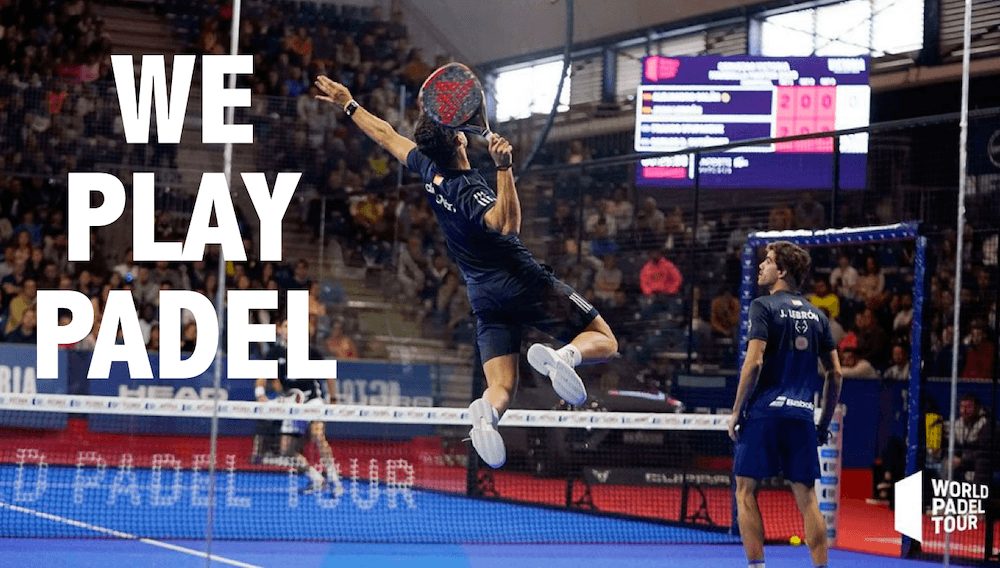I’m a massive fan of one of the fastest growing sports in the world: padel tennis. No, it’s not paddle misspelled. It’s not platform tennis nor paddle tennis. It’s not pickle ball, either. It’s one of the most elastic sports in the world in that it is supremely easy to play yet difficult to play very well. From 3 years old to 80+, you can play and have fun at padel. Played almost exclusively as doubles, rallies last around 60-70% longer than lawn tennis due to the ease of play and the use of the surrounding walls; also the service is a far less offensive weapon than in tennis. If you’ve played lawn tennis and squash, you’ve probably got a great base for the game, although padel is formally neither. Increasingly there are younger players who are pure padel players, brought up on the bandeja, bajada, chiquita and vibora (all specific strokes to padel). The padel is a perforated solid bat with ever more sophisticated materials. Think of it as an oversized ping pong racquet. The balls are like tennis balls but a fraction smaller and a little less lively. If you’re right-handed, playing with a left-hander can be quite the advantage. The origin of the sport, meanwhile, is quite amusing. It was recounted to me by my father who introduced me to the sport when I was just 10 years old in 1974, back when it began.
Padel tennis origins
Padel was born in 1969, after a successful Mexican businessman, Enrique Corcuera, invested in a beautiful holiday house on the steep hillside of Las Brisas, on the Costa Azul of Acapulco. His younger wife, Viviana, however insisted on having a tennis court so that she could pursue her beloved tennis lessons… or she basically wasn’t coming. Despite the awkward hilly terrain, Corcuera acquiesced and had built an improvised mini tennis court, replete with stilts and walls (built into the hill). At the beginning, they used cut-off tennis racquets and tennis balls. Eventually they got wooden racquets that were used for paddle tennis in the US.
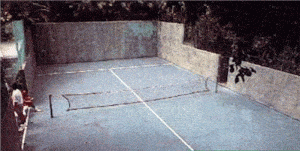
The first ever public padel court was built in 1974 at the Marbella Club (see above), on the Costa del Sol in Spain, after Prince Alfonso Hohenlohe (the elegant founder of the Marbella Club) visited his friend, Enrique. Enchanted with the game, Hohenlohe brought the dimensions back to the Marbella Club and built the first public court in lieu of some shambolic tennis courts that sat on the right as you drove down the lane to the Club’s pool and beach. As you can see in the first court, the walls were so low, it was so easy to hit the ball out of the court that you’d lose a point if you did so. Today, with the higher mesh walls, it’s a far greater feat to hit it out, so it’s a good way to win the point.
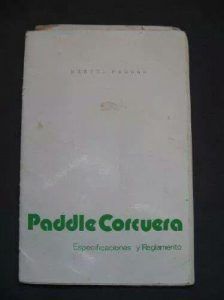
As my father reported, Enrique Corcuera eventually solidified his place in sporting history by publishing a pamphlet called the PADDLE CORCUERA, defining the size of the court, and the rules still more or less in effect today. Corcuera is to padel what St Andrews is to golf. With changes to the game coming through technology and ever-better players, the rules have evolved a bit and become standardised across all countries. Furthermore, the name definitively became PADEL, due to the predominance of the hispanic players.
The evolution in the padel equipment
Since I’ve been playing ever since the beginnings, I have seen the evolution in racquets. Below is my racquet from the late 1970s (the wooden Marc) and my current racquet of choice (Nox). In between the two below (left and centre), I also own a fibreglass version (not pictured) that is a bit bigger and thicker than the wooden one. The newer Nox AT10 racquet is made of a composite of materials (notably carbon and HR3 foam).
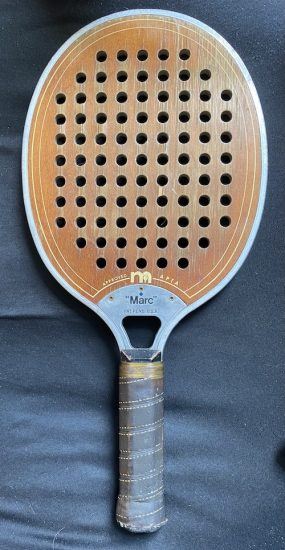
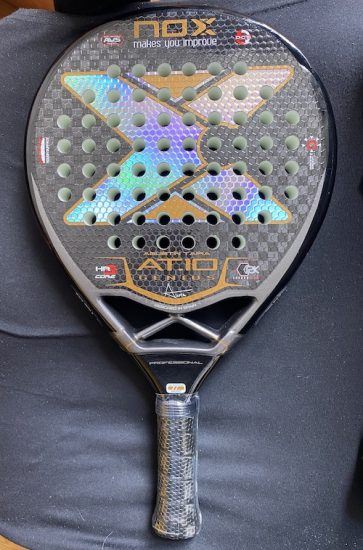
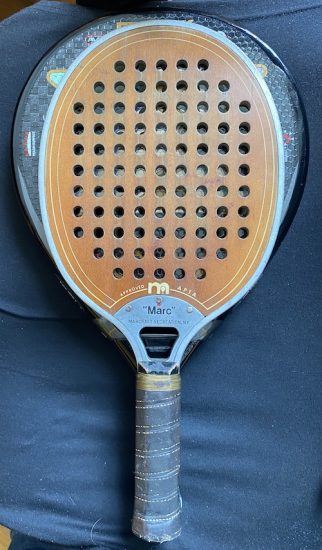
On far left, a 1970s wooden Marc racquet with metal rim. In the centre, a 2020 Nox AT10 Tapia racquet. On the right, a superposition to see the difference in sizes. In terms of weight, the Marc racquet is 483g versus 366g for the Nox.
Advantages to playing padel tennis:
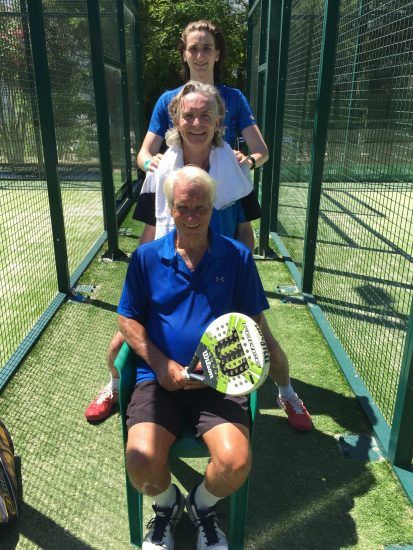
- Padel appeals to a wide population. It’s cross-generational, meaning grandparents can play with their grandchildren and play competitively (see photo to the right).
- The points last considerably longer than in lawn tennis (and racquetball).
- Padel is a family game. Men, women, and youth can compete together without physical strength being the sole determinate of the winner.
- Because the court is small, everyone can easily speak to one another. It tends to bring everyone closer, making social conversation more likely. It’s the kind of game where we celebrate the opponent making a good shot — and hopefully it will stay that way! Play with a smile!
- Thanks to the surrounding walls, it never takes long to gather balls in between points, meaning that you get in a lot of play per hour. Further, since points last longer, you never have time to be bored.
- When all four players are of roughly the same level (and they don’t necessarily have to be that good), padel can be a great way to gain physical fitness.
- Padel is an entertaining sport to watch as you’ll surely agree when you watch El Punto Más Viral below.
Disadvantages to playing padel tennis:
- It’s easy to look like a fool. You can miss some of the easiest shots. It happens to me all too frequently.
- If your partner is noticeably less good than you are and you’re playing against opponents who are so competitive they only care to win, you may find yourself “in the fridge” where they only play on your partner. Brrrrrr.
- Otherwise, the last big challenge with padel is that it’s highly addictive.
If you want to get a feel for the game, take a look at this one point, featuring the world’s best pair (in white).
How many padel courts and active players are there in the world?
During the last few years padel has spread globally and is now played in 57 countries. You will find courts in many regions in Southern Europe as well as in South and, increasingly, North America. Specifically, it can be found in Argentina, Brazil, Uruguay, Chile, Paraguay and Mexico in Latin America. It is cropping up in many European countries (Ireland, the UK, Sweden, the Netherlands, Belgium, France, Italy, Greece, San Marino, Germany, Austria, Switzerland, Lithuania, Portugal, Poland and of course Spain). There are courts now even in Asia (Singapore), Africa (Egypt) and the Middle East (Turkey & UAE). Below I’ve listed the number of padel courts as it stands today in the most popular countries.
The Mexican Padel Association says that there are now 51 national padel federations and estimates that there are currently 18 million active players worldwide. I estimate that there are around 40,000 padel courts globally (depending on what the real number is for Argentina). This compares with an estimated 489,000 lawn tennis courts in the world per the International Tennis Federation (ITF) across 195 nations [via Statista]. For all the statistics I was able to find, these number reflect only the public courts. For the lucky few, there are some people that have built private courts in their backyards…. and why not, they’re cheaper and smaller than lawn tennis courts. Below I’ve tabulated the estimated total of available courts, in order of the largest number of courts.
#1 El padel in Spain
Spain is the dominant country in the world of padel. In the current top ten players of the World Padel Tour (WPT), Spaniards own the top two places among both men and women. In fact, the top 10 women are ALL Spanish. Among the men, there are six Argentinians. (Argentina was once the ruler of the padel roost in terms of number of padel courts and players.) There are approximately 20,000 padel courts and 4 million active players in Spain. And despite the warmer clime, there are surprisingly plenty of indoor courts, too!
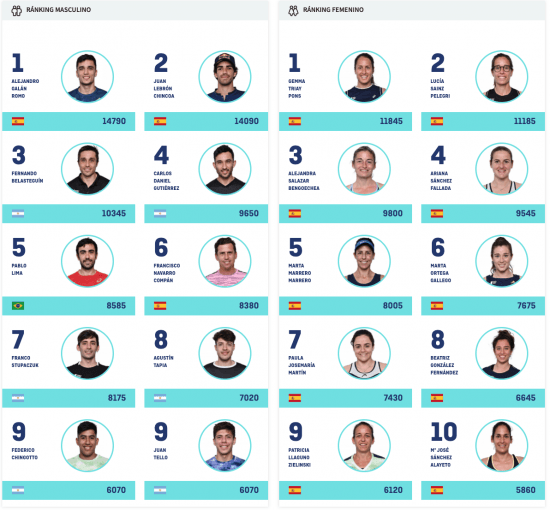
In Spain, where padel far outpaces lawn tennis, it was estimated back in 2014 that there are around 900,000 padel racquets sold each year compared to 400,000 tennis racquets. [Source] I imagine that number has now far eclipsed 1 million.
in Argentina (updated June 8 2021)
Padel was brought to Argentina in 1970s by Julio Menditengui. Argentina is the second most penetrated padel country in the world. Sources vary immensely. It seems that there are at least 2 million active players and 10,000 courts, although I did see a figure (no cited source) that said that there are as many as 35,000 courts in Argentina or as few as 4,900 (2,500 clubs) [source]. What’s for sure is that it became popular for all levels of society and is common everywhere, a bit like basketball courts are in the US. With the protracted economic difficulties, it’s understandable that many public courts were left to the weeds.
in Italy
Italy has been experiencing a boom, with some 1,800 courts in 2020. [source] There are 11,000 licensed padel players in Italy.
in Mexico
My preliminary guestimate is around 1000 courts in all of Mexico. But I’m still looking for a solid number.
in Portugal (updated Jun 8 2021)
Portugal sports 250 clubs, with nearly 1,000 courts (of which 664 are officially listed by the Federação Portuguesa de Padel) and some 100,000 players, all growing substantially each year (there were 144 clubs in 2019). [Source Jornal Economico]
in Sweden
In 2019, it was reported that there were 717 padel courts in Sweden, principally in and around Stockholm and Gothenburg. That is double the number in 2018 when there were 360 padel courts. Source. The number is presumably moving quickly toward 1,000.
in France
There are now 650 courts [source] and growing fast, with some 60,000 players nationally. My favourite club in Paris is Casa Padel where there are 12 indoor courts. But you can find padel in virtually all major metropolitan centres and certainly down on the Mediterranean coast.
Other countries of note, in alphabetical order
- Belgium 378 courts and 40,000 players [source for Europe]
- Canada 45 [source]
- Denmark 100
- Finland 250 courts with another 150 in the works. There are purportedly 15,000 players.
- Germany 62
- Greece 41
- Norway 36 courts and 20,000 players
- The Netherlands 324
- UK 100+. As of November 2020, the official number was 97 padel courts at 50 clubs, with only 32 are indoor. As a matter of record, I know of one other private court that is not listed yet, so that’s actually 98…. Here’s the latest listing of clubs in the UK via the LTA. As I’m based in London, I’m certainly excited by the fact that we now have a 6-court club at Rocks Lane in Chiswick. Hopefully, there’ll be two more at Queens Club next year.
- USA, where padel was only introduced in 2012, has 65+ courts [source] including Wynnwood Padel, a club with 8 courts in Miami in which my cousin Nalle Grinda was involved. Padel is about to rocket in the US, with a slew of courts being built privately as well.
Playing professionally
The professional game has truly made leaps and bounds in terms of competitivity and I believe that watching the pros is genuinely exciting. There is very little downtime during play as balls are easy to recuperate (no ball boys or girls needed). The World Padel Tour (WPT) does a great job of filming live and providing highlight clips. Check out their channel here. The top two players on the World Padel Tour men’s tour earned just under $120,000 each, while the top two players on the WPT women’s tour earned just over $50,000 each. As noted on World Padel Insider, this is based on actual prize money won and bonuses from the WPT. It should be noted that endorsement earnings are protected by private information laws. For now, for the pros, it’s essentially all about Spain and Argentina. To train with quality coaches and get in serious tournament play, where you can avoid heavy travel costs, Spain is the hotbed of all talent, including foreigners who’ve moved there. Hopefully, though, we’ll soon start to see some French, Italian and Swedish players break through.
Investing in Padel Tennis
With the spawning of padel tennis courts and clubs, the big question is how to do so and make money. A good padel court costs about US$28,000 (range $22,000-35,000). But, you can fit 2.5 padel courts in the space of a regular lawn tennis court. If you skimp on inter-court space, you can actually do 3 per tennis court. The dimensions of a padel court are 10 x 20 metres (32 ft 10 in by 65 ft 7 in). The most awkward thing about padel is that, while it’s tremendously fun to play on the Costa del Sol (where there is mucho sol), it’s best to have a tall roof or play indoor in countries where the climate is less accommodating. Roofs and/or tall indoor spaces change the costs, but on the plus side guarantee year-round play. A covering roof (with open sides), for example, will set you back about $30,000 more. Of course, depending on where you’re building, zoning laws can be an issue. And the only other thing to consider is the groundwork (as you do for any sports terrain). Where padel is already installed in the region, it doesn’t take long to build a loyal gang of players. Critical to the success of any court is having (a) a core group of fun players, (b) a social pro who knows how to pull together good games, and (c) a good pro who knows how to teach the game.
The future of padel … at the Olympics?
Hopefully, this post will give you enough incentive to find out about padel near you. I’m extremely bullish on the prospects of padel. I tend to have four rules (in order of priority) when I play (I’m 56 years old):
- Have fun
- Don’t get injured
- Try to play well
- Try to win (but not at the expense of the above)
Padel Ryder Cup 2021…
If you’d like to see some fun padel and do some welcome international tourism, check out the Americas v Europe padel tournament taking place 29-31 July in Båstad, Sweden. In reality, it’ll be Spain versus Argentina and one Brazilian! But I expect the quality and ambiance to be highly engaging. See here for more.
If it is played in some 57 countries around the world, padel still needs to grow further in order to be an Olympic sport. To qualify, the sport must be played in at least 75 countries. I’m ever hopeful for the future of padel. What about you?
Further reading: Padel Tennis Wikipedia Page

